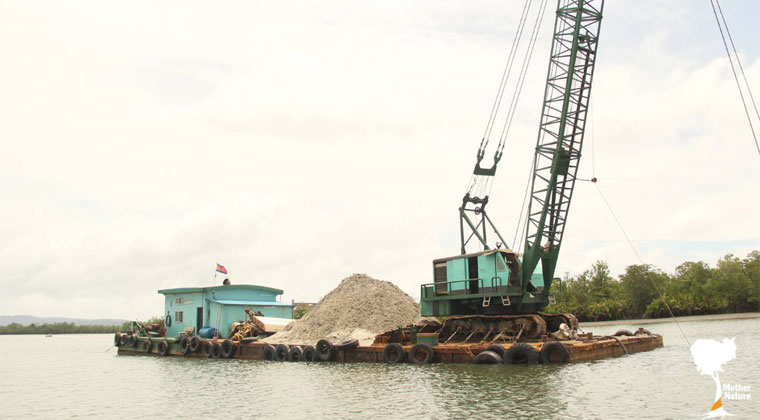According to The Cambodia Daily, a Singaporean law firm has reportedly been hired by an environmental non-governmental organisation to investigate alleged irregularities in Singapore's importation of Cambodian sand.
NGO Mother Nature founder, Alex Gonzalez-Davidson, made the announcement on Jan 4, 2017, in a Facebook message.
Singaporean lawyer Eugene Thuraisingam acknowledged that his firm was looking into the case, but declined to elaborate, the article said.
According to Gonzalez-Davidson, the law firm is “looking into the relevant laws that might have been broken there, in relation to the social and ecological destruction the mining has caused, or in relation to the government importing Cambodian sand which is tainted by issues of corruption, smuggling, tax-evasion, etc.”
The goal, Gonzalez-Davidson said, was to halt sand imports by Singapore completely:
“Our goal is... that the mining and export of coastal sand from Cambodia is eventually regarded as too toxic by the Singapore government and that they are forced to stop getting involved,” he said.
Cambodia has over the years been accused of routinely under-reporting the total tonnage of sand exports to Singapore between 2007 and 2016.
In February 2016, Sydney Morning Herald reported that Singapore's import of sand for land reclamation has been destroying Cambodia shores.
The modus operandi for removing Cambodia’s sand was described in relatively straightforward terms.
The Singapore government reportedly contracts private companies to import the sand.
This is believed to be so as a diplomat in Singapore’s embassy in Phnom Penh had previously told activists in a letter in January 2016 that the “import of Cambodian sand to Singapore is done on a commercial basis... the Singapore government is not involved in these commercial transactions”.
Sand that has been removed from remote areas in Cambodia are protected by allegedly corrupt navy and police, while government ministries responsible for mining turn a blind eye.
The sand is then hauled up by smaller ships to huge mother ships anchored further out to sea.
Moreover, The Cambodia Daily cited Commerce Ministry records showing the company responsible for sand dredging is partially owned by two daughters of Cambodia’s strongman prime minister, Hun Sen.
For this latest report, JTC Corporation and the Ministry of National Development did not respond to queries for comment.
Discrepancy in sand export and import numbers
Numbers have not tallied in the lucrative sand trade.
Singapore reported 73.6 million tonnes of imported sand to the U.N. Commodity Trade Statistics Database, known as Comtrade. Cambodia's figures on its exports have been described as "radically lower" and does not match the imported figures.
Cambodia's Ministry of Mines and Energy recorded 16.2 million tons of sand exports during the period, while statistics from the Finance Ministry’s general department of customs and excise show roughly 2.7 million tons leaving for Singapore.
Singapore is more than 1,000km from Cambodia by sea.
According to the United Nations Environment Programme, Singapore is supposedly the largest importer of sand worldwide and the world’s biggest user per person.
Singapore responded to criticisms about importing Cambodia sand previously
In 2010, the Singapore government rejected a report by an environmental group that claimed that Singapore imported Cambodian sand illegally and without regard for the environment.
MND said then that they “are committed to the protection of the global environment” and “do not condone the illegal export or smuggling of sand, or any extraction of sand that is in breach of the source countries’ laws and rules on environmental protection”.
In The Straits Times report, MND also noted that contracts by Jurong Town Corporation (JTC) -- which engages land reclamation suppliers -- stipulates that the sand vendors have to act responsibly and it reminds them to observe source country regulations.
In November 2016, National Development Minister Lawrence Wong said Singapore is piloting a new reclamation technique using dikes to get around its reliance on sand.
Top photo via Mother Nature
If you like what you read, follow us on Facebook and Twitter to get the latest updates.
If you like what you read, follow us on Facebook, Instagram, Twitter and Telegram to get the latest updates.
